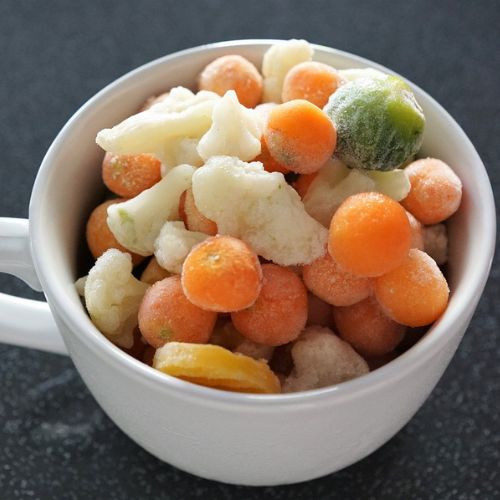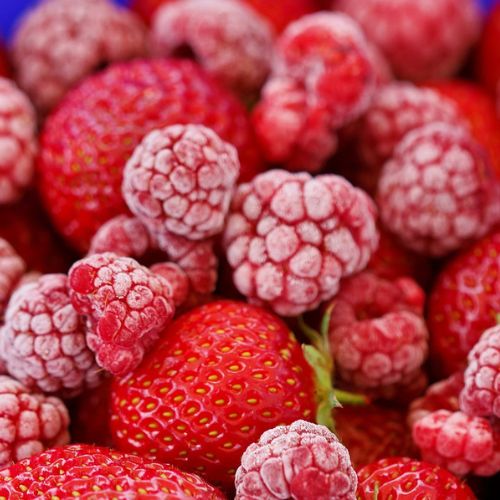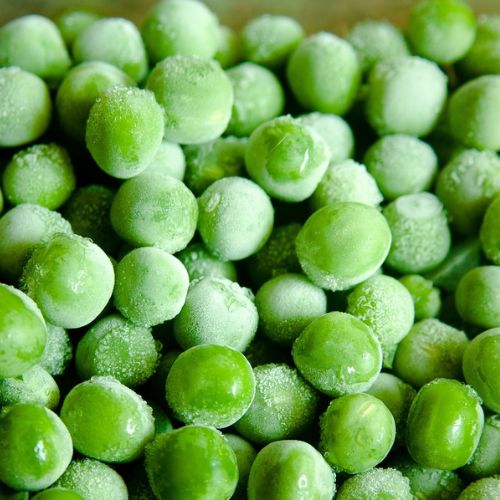What Causes Ice Crystals on Frozen Food?
Frozen food provides convenience and allows for long-term storage of perishable items. However, one common issue that can arise with frozen food is the formation of ice crystals. Ice crystals on frozen food, also known as freezer burn, can affect the quality, taste, and texture of the food. Understanding the causes of ice crystal formation and how to prevent it is important for preserving the integrity of frozen food.
If you are finding ice crystals on your food in the freezer, it is likely due to a combination of factors that can contribute to freezer burn. Freezer burn occurs when moisture from the food evaporates and forms ice crystals on the surface of the food.
What Causes Ice Crystals on Frozen Food?

Freezer burn occurs when moisture from the food evaporates and freezes on the surface, forming ice crystals. There are several factors that contribute to the formation of ice crystals on frozen food:
- Improper packaging: Inadequate packaging is a primary cause of ice crystal formation. When food is not properly sealed or wrapped, air can come into contact with the food, leading to moisture loss. This moisture then condenses and freezes on the surface of the food, resulting in the formation of ice crystals. It is essential to use airtight containers, freezer bags, or freezer wrap specifically designed for freezing to minimize exposure to air.
- Temperature fluctuations: Frequent temperature changes within the freezer can contribute to the formation of ice crystals. When the temperature fluctuates, the food may partially thaw and then refreeze. During the thawing process, moisture is released from the food, and when it refreezes, ice crystals form on the surface. Maintaining a stable temperature in the freezer and avoiding frequent door openings can help minimize temperature fluctuations.
- Extended storage duration: Over time, even well-packaged food can suffer from ice crystal formation. The longer food remains in the freezer, the higher the chances of moisture loss. It is important to adhere to recommended storage times and use frozen food within a reasonable period to maintain its quality.
The presence of ice crystals on frozen food can lead to various negative effects. It can cause the food to become dry, resulting in a loss of flavor and texture. Ice crystals can also contribute to freezer burn, which can further degrade the quality of the food. While freezer burn is not harmful to consume, it can lead to unappetizing and less enjoyable food.
To prevent or minimize ice crystal formation on frozen food, here are some recommended practices:
- Proper packaging: Ensure that the food is tightly sealed in appropriate freezer-safe containers or packaging. Use high-quality freezer bags, airtight containers, or freezer wrap to provide a barrier against air and moisture.
- Rapid freezing: Freeze the food as quickly as possible. Rapid freezing helps to minimize the size of ice crystals that form, preserving the quality of the food.
- Consistent temperature: Maintain a consistent temperature in the freezer. Avoid frequent door openings, as they can cause temperature fluctuations. Keeping the freezer at a stable temperature will reduce the chances of moisture loss and ice crystal formation.
- Organized freezer: Properly arrange and space out items in the freezer to promote adequate airflow. Overpacking the freezer can restrict airflow and lead to uneven temperatures, potentially contributing to ice crystal formation.
By following these practices, you can minimize the formation of ice crystals on frozen food and help maintain its quality. Freezing food properly and storing it in appropriate packaging will ensure that your frozen food remains fresh, flavorful, and free from ice crystal damage.
Is it bad if frozen food has ice crystals?

The presence of ice crystals on frozen food is not necessarily an indication that the food is unsafe to consume. However, it can negatively impact the quality, taste, and texture of the food. Ice crystals are typically associated with a condition called freezer burn, which occurs when moisture evaporates from the food and freezes on the surface.
While freezer burn doesn’t pose any health risks, it can cause the food to become dry, bland, and less appetizing. The texture of the food may also be affected, resulting in a mushy or tough consistency. The formation of ice crystals can lead to changes in flavor and overall quality, making the food less enjoyable to eat.
To minimize the occurrence of ice crystals and prevent freezer burn, it is important to follow proper freezing and storage practices. This includes using airtight packaging, maintaining a consistent freezer temperature, and adhering to recommended storage times. By doing so, you can help preserve the quality of the frozen food and minimize the formation of ice crystals.
If you encounter frozen food with significant ice crystal formation or freezer burn, it is generally recommended to assess the quality of the food before consuming it. If the ice crystals are minimal and the food appears to be in good condition otherwise, you can still consume it, but be aware that the texture and flavor may be compromised. However, if the food shows signs of excessive freezer burn, such as a strong off-putting odor, significant discoloration, or a significant amount of ice crystals, it is best to discard it.
In summary, while the presence of ice crystals on frozen food is not harmful, it can affect the quality and enjoyment of the food. By following proper freezing and storage practices, you can minimize ice crystal formation and maintain the best possible quality of your frozen food.
Should you reject food with ice crystals?
The presence of ice crystals on frozen food, while not harmful to consume, is an indication that the food may have experienced freezer burn. Freezer burn can negatively impact the quality, taste, and texture of the food, making it less enjoyable to eat. Therefore, it is generally recommended to assess the condition of the food and use your judgment when deciding whether to consume it.
If the ice crystals on the food are minimal and the food appears to be in good condition otherwise (no significant discoloration, off-putting odor, or excessive freezer burn), you can still consume it. However, be aware that the texture and flavor may have been compromised due to the freezer burn. You can try to trim off any freezer-burned portions before cooking or eating the food.
On the other hand, if the food shows signs of significant freezer burn, such as a strong off-putting odor, excessive discoloration, or a substantial amount of ice crystals, it is best to err on the side of caution and discard it. Freezer burn can significantly affect the quality of the food, and consuming severely freezer-burned food may result in an unpleasant taste and texture.
Ultimately, the decision to reject or consume frozen food with ice crystals depends on the extent of the freezer burn and your personal preference. It’s important to use your judgment and consider the overall condition of the food before making a decision. When in doubt, it is safer to discard the food to avoid any potential risks or dissatisfaction with the taste and texture.
Is it okay to eat food that has frost on it?

What Causes Ice Crystals on Frozen Food?
Frost on food is typically an indication of moisture that has evaporated from the food and condensed on the surface, forming ice crystals. While the presence of frost does not necessarily mean that the food is unsafe to eat, it is generally recommended to assess the condition of the food before consuming it.
If the frost on the food is minimal and the food appears to be in good condition otherwise (no signs of spoilage, unusual odors, or discoloration), it is likely safe to consume. However, it’s important to be aware that the texture and taste of the food may have been affected by the moisture loss and subsequent frost formation. You can try to remove the frost by gently wiping it off before cooking or eating the food.
However, if the food shows signs of excessive frost, such as a thick layer or frost accompanied by significant discoloration, off-putting odor, or other signs of spoilage, it is best to discard it. Excessive frost can indicate prolonged exposure to air and moisture loss, which can lead to freezer burn or deterioration of the food’s quality.
It’s crucial to use your judgment when evaluating the condition of food with frost. If you have any doubts about its safety or quality, it is safer to discard it to avoid any potential risks associated with consuming compromised food.
In summary, while consuming food with minimal frost is generally safe, it’s important to assess the overall condition of the food and consider any signs of spoilage. If the frost is excessive or accompanied by other concerning indicators, it is best to discard the food to prioritize your health and enjoyment.
How do ice crystals damage food?
Ice crystals can damage food in several ways:
- Dehydration: Ice crystals form when moisture evaporates from the food and freezes on its surface. This process leads to dehydration of the food, causing it to lose moisture. Dehydration can result in a dry and tough texture, affecting the overall quality and palatability of the food.
- Texture degradation: As ice crystals form, they can disrupt the structure of the food, especially in delicate items like fruits, vegetables, and meats. The formation of large ice crystals can damage cell walls and protein structures, leading to a mushy or rubbery texture. This texture degradation can make the food less enjoyable to eat.
- Flavor alteration: Ice crystal formation can also impact the flavor of the food. The loss of moisture and disruption of the food’s structure can lead to changes in taste. Foods may become bland or develop off-flavors due to the damage caused by ice crystals.
- Oxidation: When ice crystals form, they create a barrier between the food and the surrounding air. This barrier can prevent proper airflow and increase the chances of oxidation. Oxidation can cause the food to develop rancid flavors, off-putting odors, and potential nutrient degradation.
- Freezer burn: Ice crystals on frozen food are often associated with freezer burn. Freezer burn occurs when moisture is lost from the food, exposing the food’s surface to air. This exposure can result in the development of dry, discolored patches on the food, further impacting its taste, texture, and overall quality.
Final Thoughts On “What Causes Ice Crystals on Frozen Food?”
It is important to note that while food with ice crystals or mild freezer burn is generally safe to consume, the quality and enjoyment of the food may be significantly diminished. To minimize the damage caused by ice crystals, following proper freezing and storage practices, including using airtight packaging, maintaining a consistent freezer temperature, and adhering to recommended storage times is advisable. These measures can help preserve the integrity and quality of the food, minimizing the negative effects of ice crystal formation.